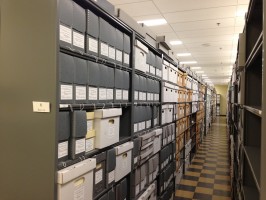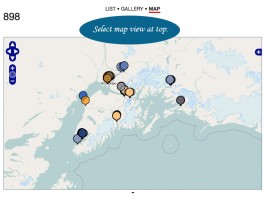1964 Alaska earthquake images a click away
by Jamie Gonzales |
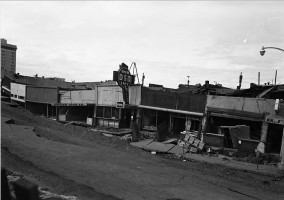
Fourth Ave., Anchorage, 1964. Robert and Wilma Knox papers, Archives and Special Collections, Consortium Library, University of Alaska Anchorage.
"Do you have a sweater?" asks Michael Catoggio, the 1964 earthquake project archivist. We're about to take a trip back in time and it promises to be chilly. Or, more accurately, temperature-controlled.
If you've visited the UAA/APU Consortium Library, you've probably wandered past the entrance to Archives and Special Collections, a deceptively quiet-looking suite on the third floor. Don't be fooled by the modest front end. That's just the tip of the iceberg. Inside are the industrious archivists and the massive archive they manage, pulsing with stories from Alaska's history.
History buffs, academics and storytellers, take note. Recently, a grant from the U.S. Institute of Museum and Library Services and the Alaska State Library allowed Arlene Schmuland, head of Archives and Special Collections, and Catoggio to create a new portal, featuring searchable images of Alaska's 1964 earthquake, as well as a round-up of all the '64 quake resources the state has to offer.
Want to see what 4th Avenue looked like post-quake? Just type in your query here and it'll search through meticulously cataloged earthquake images. All this just in time for the 50-year anniversary of The Great Alaska Earthquake (March 27, 1964).
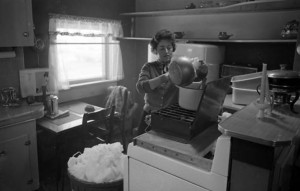
Melting snow in an Anchorage kitchen post-quake, 1964. Robert and Wilma Knox papers, Archives and Special Collections, Consortium Library, University of Alaska Anchorage.
"A 9th grader in California who wants to do a paper on the 1964 Alaska earthquake can access almost 900 photos," say Catoggio. "The other thing that we did was create a blog that basically is a guide to the significant collections of '64 earthquake-related materials in the state. Anyone doing research or even just interested can go to the ladder website and find all the significant collections."
This isn't the first digital project they've collaborated on. Archives and Special Collections also feeds collections into what could be considered the state's master archive, Alaska's Digital Archives. The newly digitized earthquake materials will become part of that master archive.
Navigating the archives
Picture the tidiest garage you've ever seen, now quadruple it in size. Rows and rows of carefully labeled boxes-there's room for about 9,100 cubic feet of materials-make up the physical archives. This behind-the-scenes area is not open to the public, but the Archives and Special Collections research room is a nice, quiet space to work with materials checked out from the archives. (Take a look at this online guide to the collections onsite and talk to a friendly archivist if your interests extend into other areas of Alaska history.)
Schmuland and Catoggio did the hard work of sifting through hundreds of those collections in the physical archives to find all the '64 quake materials to feature online-primarily slides and photographs.
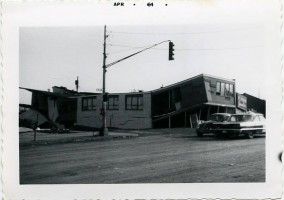
Bagoy's Florist, Anchorage. Edith and Edward Lindsay papers, Archives and Special Collections, Consortium Library, University of Alaska Anchorage.
"It might take the average person hours to dig out a couple earthquake pictures, let alone the 800-plus that we found," says Catoggio.
Telling the whole story
"One of the things we run into as archivists is, as we come up on major anniversaries, statehood or whatever, suddenly we get whammed with requests," Schmuland says. "I knew this was going to be a big one, since it's still in living memory for so many."
Schmuland decided to get ahead of the rush almost two years ago and began pulling in collaborators around the state, museums and others who might not have the resources to digitize their own collections.
"I knew this couldn't be just us. For Valdez, this is a Valdez story. For Seward, it's a Seward story. We don't want Anchorage to tell Valdez's story," she says. "What I wanted to do was give Valdez a chance to tell their story and bring it to a wider audience."
One other super cool feature of the digitized photo library: the mapping function. View the photos in a list, in the gallery or on the map.
Whenever Schmuland and Catoggio were able to determine the geographic coordinates of a photograph, they included that information. So, you can pull up Southcentral Alaska with a map overlay of more than 500 photographs and take a virtual tour of the region in 1964.
Maybe you have your own earthquake stories and images to share? Another bonus of creating a site like www.64akquake.org is that it leads to preservation of other collections that may be privately held, forgotten in an attic, perhaps. Although UAA's physical archives are filling up with collections, the archivists are happy to field your queries if you think you might be holding onto a valuable piece of Alaska history.
 "1964 Alaska earthquake images a click away" is licensed under a Creative Commons Attribution-NonCommercial 4.0 International License.
"1964 Alaska earthquake images a click away" is licensed under a Creative Commons Attribution-NonCommercial 4.0 International License.










